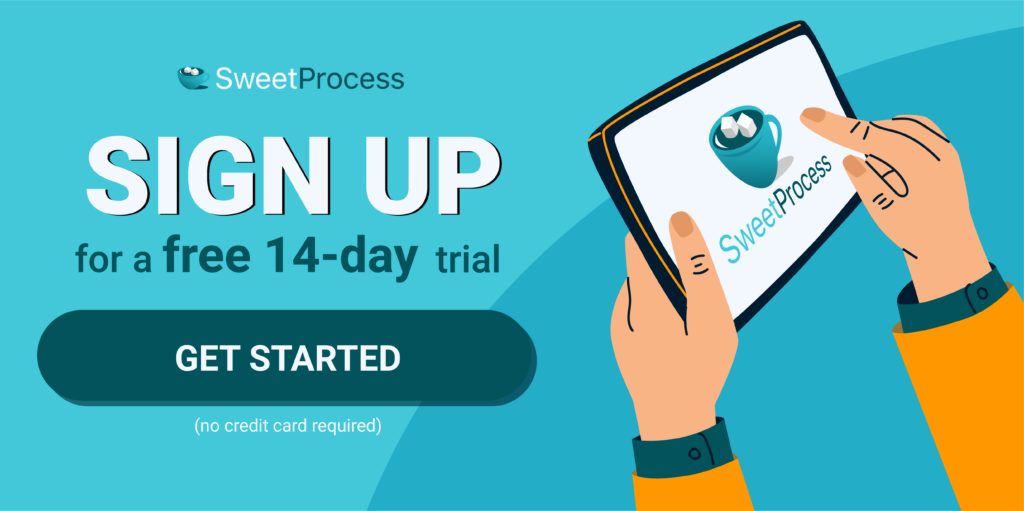Last Updated on October 25, 2025 by Owen McGab Enaohwo
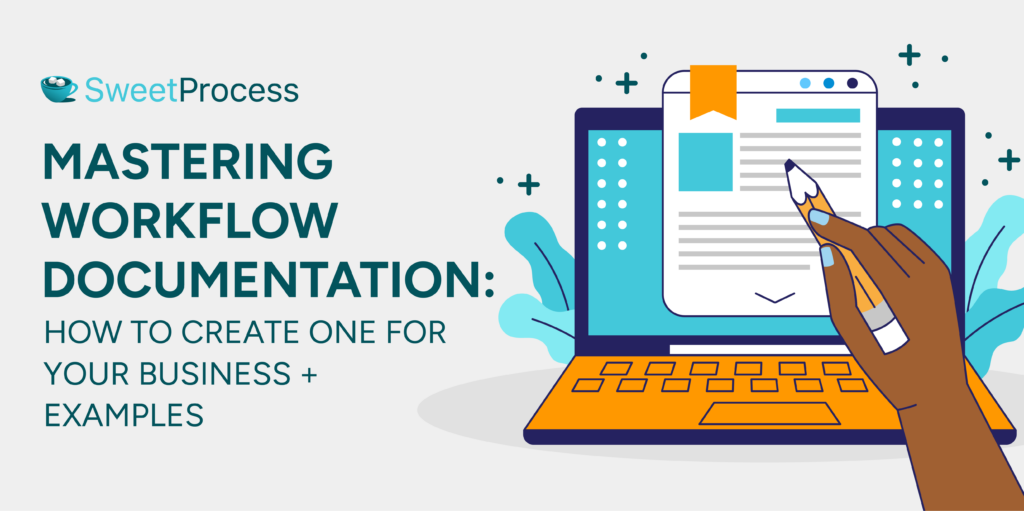
What happens when your top-performing employee suddenly leaves and takes all their process knowledge? That’s how bottlenecks begin.
For many small businesses, key operations are undocumented, living only in the minds of a few experienced employees. When team members go on leave, switch roles, or leave the company, it creates a significant knowledge gap. The result? Tasks stall, errors increase, and new hires struggle to find their footing.
Without proper workflow documentation, your business becomes dependent on individuals instead of systems. Implementing workflow management software protects you against such chaos. It outlines how work is done—from the smallest daily tasks to complex processes, so that anyone on your team can jump in and execute.
In this article, we’ll walk you through how to create workflow documentation from scratch and explore why it matters.
Investing in the right workflow documentation tool can future-proof your business operations. Sign up for a 14-day free trial of SweetProcess to get started!
Table of Contents
What Is Workflow Documentation?
How Workflow Documentation Benefits Your Business
How To Create a Workflow Documentation Process [Step-by-Step]
How To Streamline and Manage Your Workflow Documentation Using SweetProcess
Document Workflow vs Workflow Documentation: How They Differ
Workflow Documentation Examples & Templates To Inspire Your Team
Document and Manage Your Company’s Workflows Using SweetProcess
What Is Workflow Documentation?

Workflow documentation involves compiling structured records of how your company’s tasks, processes, and operations will be executed. For instance, you can use this tool to outline the steps your team should follow to complete a task, who is responsible, and the tools they need to achieve this.
Think of it as a guide for your employees to refer to as they work without needing to clarify things with the managers each time. Organizations that invest in workflow documentation reduce their reliance on tribal knowledge and accelerate onboarding, even when seasoned employees are unavailable. Here are some of the popular use cases for workflow documentation:
- SaaS customer onboarding to detail each step from the welcome email to account setup and feature training
- Employee training and HR processes on how to onboard, offboard, and manage team members
- Documentation to standardize how support agents resolve tickets or escalate issues
- Content creation pipelines that define the editorial process from topic ideation to publishing
- Client intake and service delivery documentation to map how client information is collected and managed
How Workflow Documentation Benefits Your Business

Workflow optimization is essential for any type of business. However, the only way to enjoy the full benefits is by documenting these steps and making them accessible to everyone so that it’s easier to scale operations and onboard new employees. Using a reliable documentation app for businesses can streamline this process by centralizing information, improving collaboration, and reducing the risk of knowledge silos.
Here are the key advantages of documenting these key processes.
Sharing Organizational Knowledge
Have you ever found yourself saying, “Ask Chris, he’s the only one who knows how that works”?
That’s a major red flag. With such knowledge silos, you risk losing key company information when Chris goes on leave or shifts to another company. This can stall all your projects and lead to costly mistakes.
While mastering the workflow management system, you can create a centralized knowledge repository. This way, if Chris or another manager is out of the office, every other team member knows where to find the right information and what to do next. Additionally, your team can share knowledge throughout instead of starting from scratch.
Better Collaboration
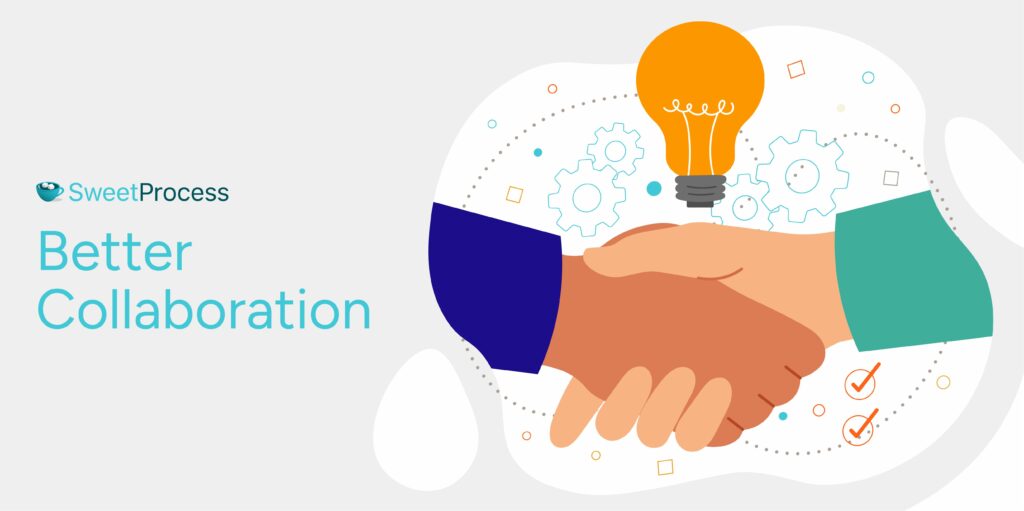
If your team constantly relies on verbal instructions and lengthy email threads, you are more likely to experience confusion. Your team members end up duplicating work, missing steps, or interrupting each other to ask for clarification.
However, once you start documenting the workflows in a centralized location, you can define every role and expectations, making it easier to collaborate. Visibility into how the workflow process works is essential if you want to improve communication among your employees and reduce frustration. Multiple team members can co-create and follow documented processes in real time.
Speed of Delivery
Think about how much time your employees take to find information. If it takes up too much of their workday, you’re affecting the company’s workflow efficiency. Documented workflows eliminate this problem since employees can access the exact steps they need to follow and complete their tasks much faster.
Thanks to the available roadmap, your employee handovers will be faster, and projects will be completed with fewer delays. For instance, if you are launching a new product into the market, there are established processes for planning the release, determining who is responsible, and outlining the steps to follow, which gives you a competitive edge.
Team Alignment
If you give two team members the same task, will they follow the same procedure? This should be a good indicator of whether your procedures are standardized. For instance, if one team member of your digital marketing team uses a design template with brand-approved fonts and colors while another freestyles and uses outdated logos and inconsistent messaging, your brand will look disjointed.
In such instances, you need documented workflows that outline content publishing checklists for each team member to follow. This way, you have a uniform and professional brand presence every time. Additionally, you can customize workflows by department, team, or function to keep your organization in sync.
Accountability
When things go wrong and you have undocumented workflows, it becomes hard to trace what happened and who was responsible. On the other hand, if the process documentation is in order, every task has an owner, there’s a version history, and transparency on which employee is working on what.
This form of documentation fosters trust across teams and enables managers to identify areas for improvement.
Security

Some industries like IT, finance, and healthcare are quite critical. Missing a single step in a process can lead to compliance violations or data breaches. In fact, the average cost of a data breach reached $4.88 million in 2024, marking a 10% increase from the previous year. That’s a heavy price to pay for process gaps or human error.
In addition, even in less regulated industries, poor documentation can lead to lost files or accidental access to sensitive data. Well-documented workflows protect your business by reducing human error and ensuring security protocols are followed consistently. You can set permissions, restrict access to sensitive procedures, and automate compliance checklists.
Continuous Improvement
For your business to thrive, you need to improve operations as things evolve. However, the best way to identify what’s working is to have a checklist that outlines your business systems. This way, you have a feedback loop—your employees can review outdated processes and suggest improvements in real time.
Workflow documentation will help you optimize tasks and experiment with suggested improvements. Once you identify which changes work best, you can incorporate them into your processes and track revisions to improve efficiency.
How To Create a Workflow Documentation Process [Step-by-Step]
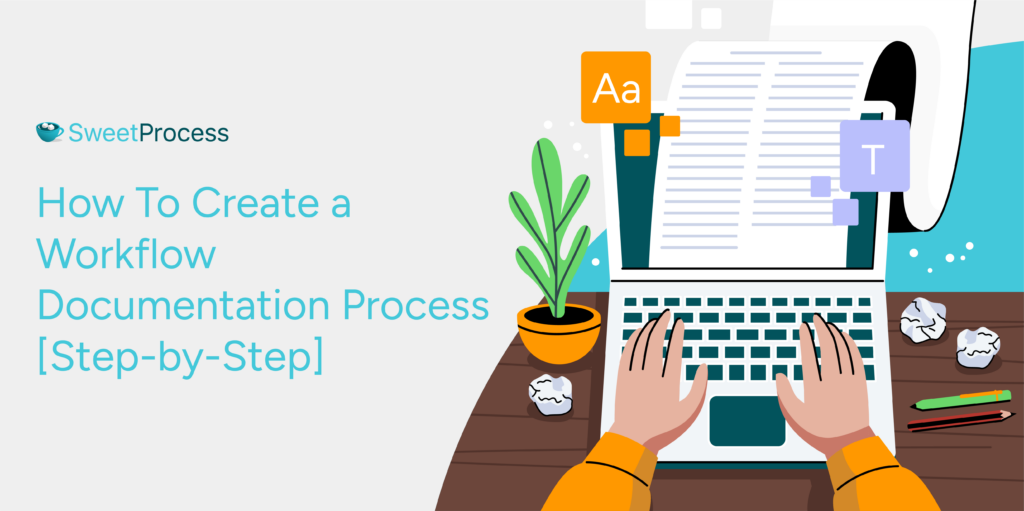
As we’ve established, documented workflows benefit your business significantly by boosting accountability, collaboration, and team alignment. But how do you create one for your organization? In this section, we’ll walk you through the exact steps to take while developing a workflow documentation process.
Here’s what to do:
Gather Already Documented Workflows
Before starting from scratch, take inventory of any existing process documents, SOPs, email threads, or team notes. You might find useful outlines hiding in Google Docs, Microsoft Word documents, or Slack conversations with team members.
For instance, Craig Bayer, the founder of Optiable, initially relied on tools like Google Docs and Word documents to document business processes. However, he found these tools ineffective in making a significant impact. He gathered this information and transitioned to SweetProcess, which allowed him to comprehensively document processes as well as incorporate images and videos where necessary, making it easier for employees to understand and follow them.
Once you have all the scattered documents, you can determine what’s missing.
Speak To the Teams
Imagine trying to document a process you’ve never experienced firsthand. That’s what it feels like if you don’t talk to the teams involved in the work. You need to speak with all departments to understand how the workflows work out.
For example, your product, marketing, and customer success teams may have a different version of the launch process. By engaging with each team, you can map out the procedures they need to follow to ensure the product launch is successful. This approach is also a great chance to build buy-in.
When teams feel heard and see their input valued, they’re more likely to follow the documented process later. Ask questions to help you gather insights that will help you refine your workflow.
Interview Individual Team Members

Once you have finished speaking with teams, conduct one-on-one interviews with key team members who perform or oversee the process on a daily basis. You can ask them questions such as:
- What slows them down
- What tools they use
- How handoffs happen
- What they wish others knew about their role
Such queries will help you identify friction points and inconsistent processes. For instance, you might realize that employees have a different understanding of the same process, or two departments are doing the same task but using different workflow management tools, or skipping steps entirely. Once you are aware of these discrepancies, you can adjust your workflow documentation to bring everything back on track.
Document the Workflow
Now that you have all the insights, it’s time to turn them into structured knowledge. Here are some good practices to follow when documenting your workflow:
- Use clear language to outline each step in the workflow
- Stick to formats that are easy to read and replicate, such as bullet points, numbered steps, and flowchart templates.
- Don’t overcomplicate things to make it easy to read
- Use examples to show how the workflow applies in real scenarios
Your documentation should comprehensively cover every angle to give the users a clear reference point.
Design the Workflow Document
The average human attention span has dropped from 12 seconds to just 8.25 seconds over the past 20 years. Therefore, you need to design your workflow document for quick comprehension. Instead of having everything in text, consider using images, videos, and charts that explain more details about the process.
Use icons, arrows, and symbols to highlight steps or approvals. The clearer the visual flow, the easier it is to use the document in real time. Before presenting it to the team, ensure that it’s simplified enough. This way, even new hires can refer to it and complete their tasks without asking for help.
Use a Workflow Documentation Software
Workflow documentation software allows you to centralize, edit, and collaborate on processes in real time. You can access tools like version control, task assignment, searchability, and templates—all in one place. These features are especially crucial for growing teams and remote companies to boost consistency and visibility across roles.
Ana McRae, a business coach and founder, emphasizes the importance of documenting processes to help you scale a business. She points out that by moving knowledge from your head into a central hub, your team can replicate your success more easily, promoting consistency and freeing up your time to focus on strategic growth.
These tools are the best for workflow automation since they integrate with your existing business tools; therefore, you can manage all projects more seamlessly.
Review and Update Regularly
What worked last year may not work today. Set regular review sessions to update your workflow documentation. For instance, you can schedule a quarterly or biannual review and assign this task to the document owners. Additionally, as you collect new information, you can edit the documents to keep them current.
Once the changes are made, ensure that you communicate them. You can also use a workflow management software that sends notifications to keep all team members aligned.
How To Streamline and Manage Your Workflow Documentation Using SweetProcess
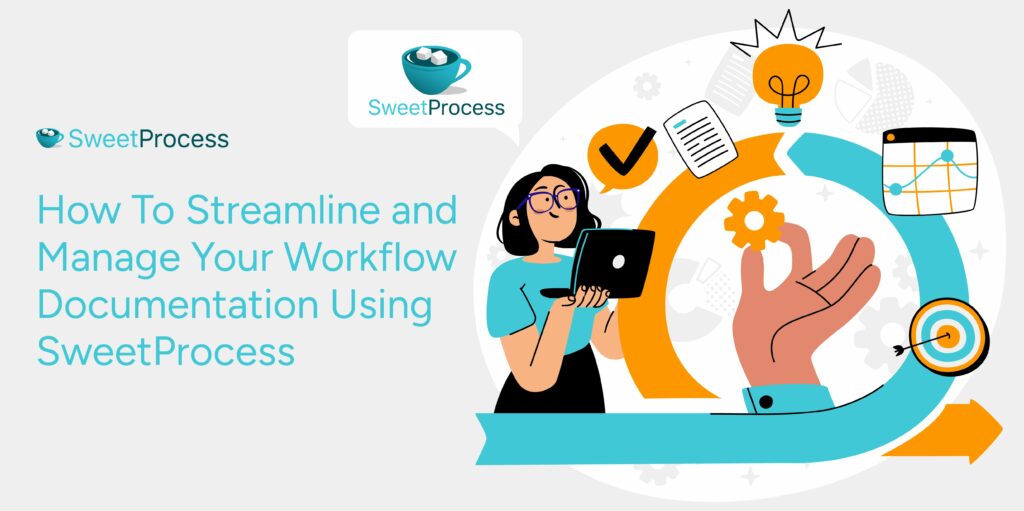
Workflow documentation doesn’t have to be a scattered collection of Google Docs and spreadsheets. You need a platform that brings structure and consistency, like SweetProcess. This cloud-based solution stands out among modern IT documentation tools by serving as a single source of truth for all your employees, facilitating easier collaboration and task execution.
Here’s how SweetProcess can work for your organization:
Document Your Standard Operating Procedures (SOPs)
Relying on multiple tasks, scattered documents, or word of mouth to train your new hires or existing employees about processes is a recipe for disaster. You need to standardize this process by documenting all your SOPs on SweetProcess. You can add step-by-step instructions, whether you need to train employees to handle customer refund requests or onboard new ones.
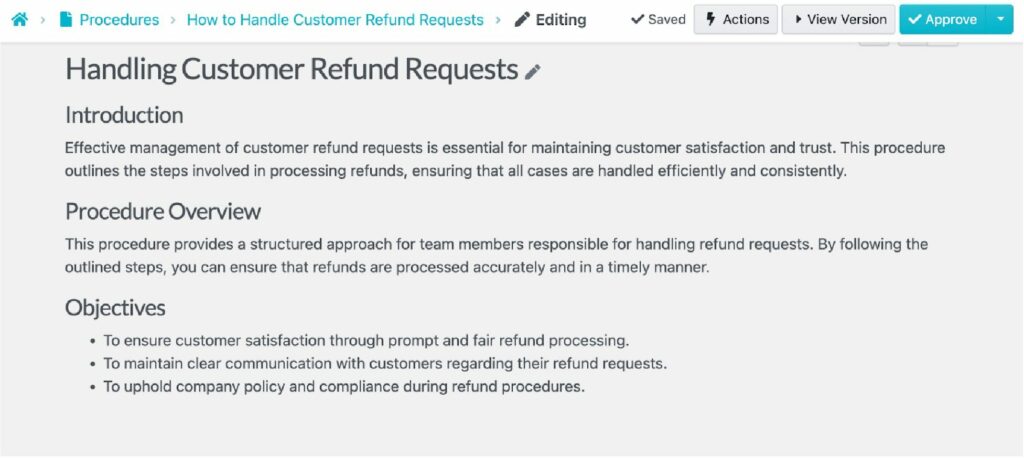
Your steps will be outlined at the bottom.
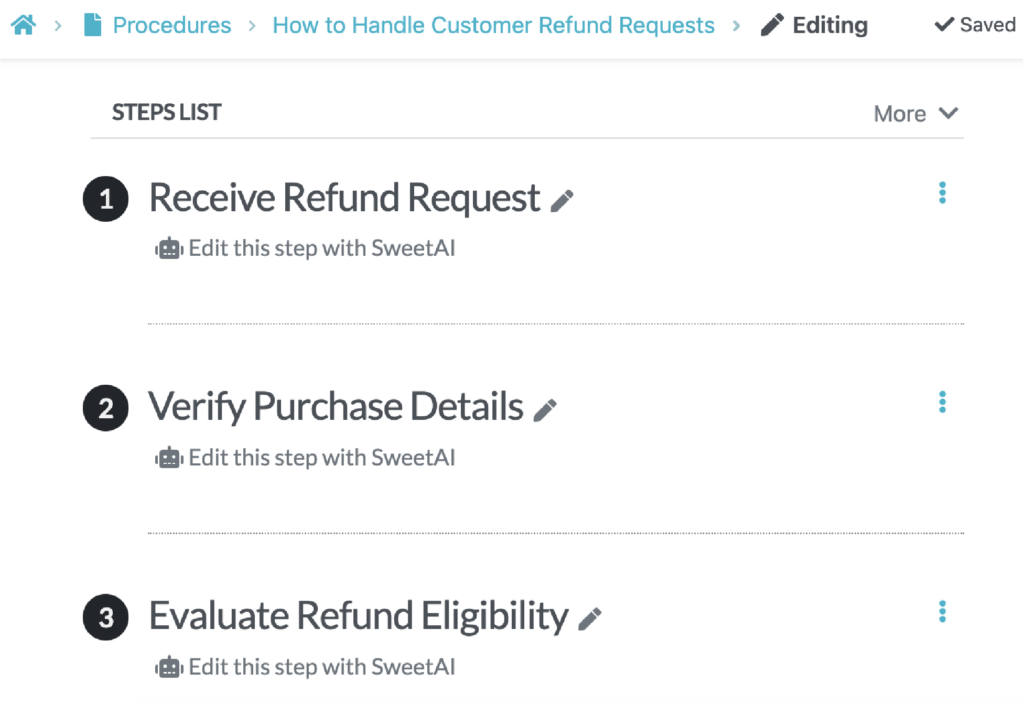
In addition to adding text, you can also incorporate images and video to further explain the SOP.

Create Processes For Your Entire Team
With SweetProcess, you can create interconnected workflows that multiple team members can access and follow. You can assign tasks, add process owners, set deadlines, and track progress, all from a single dashboard.
For instance, if you want to create your “Client Onboarding Process”, you can use SweetProcess to add the information your team needs to know.
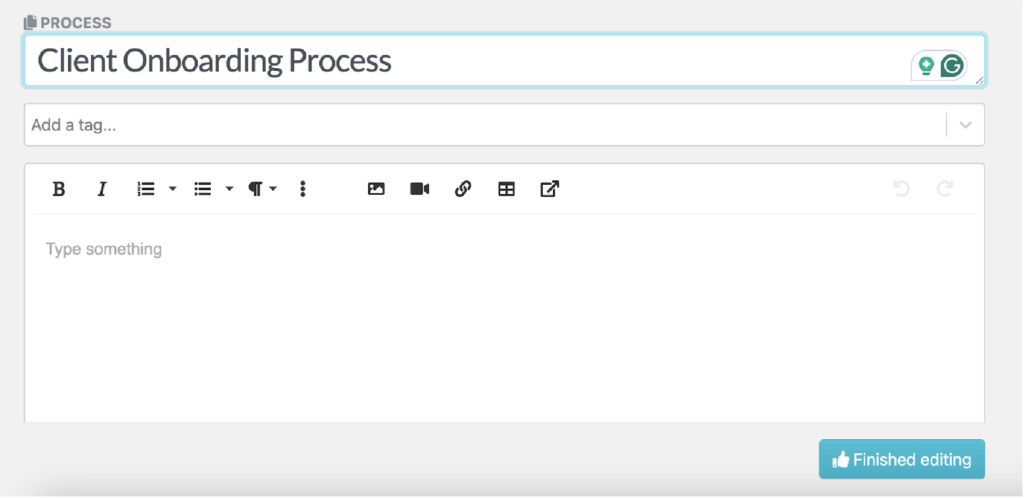
Additionally, you can create multiple procedures to make it detailed.
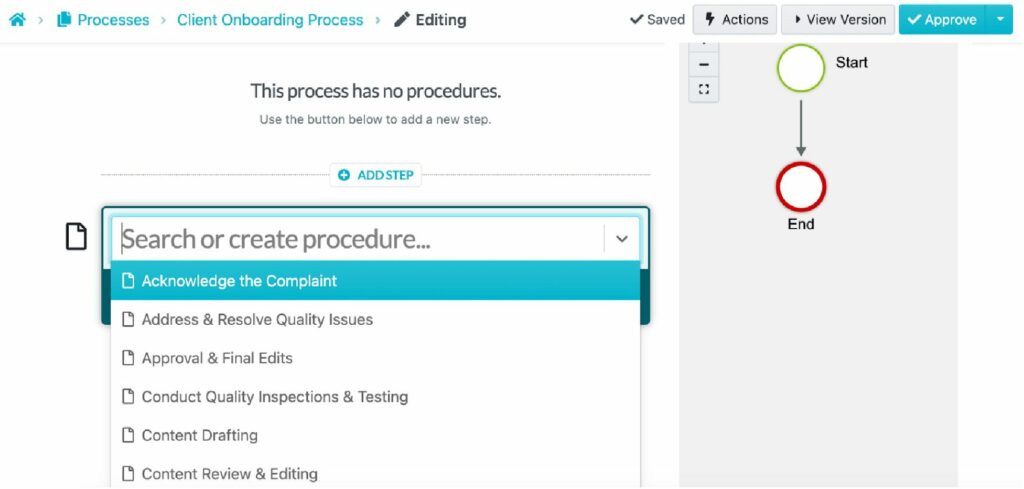
These processes make it easier to manage your company workflows.
Create Company Policies That Everyone Must Follow
If your employee handbook is stored by a single supervisor, it may not be read or followed. SweetProcess enables you to transform your policies into dynamic documents that are easily accessible. You can create them using SweetAI and update them as often as possible.
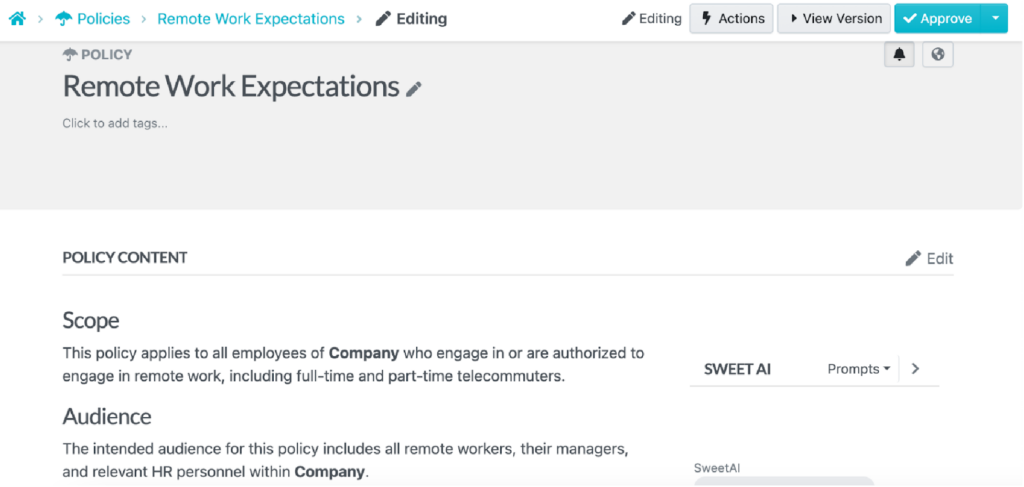
Team members can read and acknowledge policies directly within the SweetProcess system, ensuring they don’t miss any important information.
If you need to search for a specific policy, you can use the search tab to find it.

Financial advising firm, Benchmark Wealth Management, is one of the beneficiaries of SweetProcess. Although the company was expanding, it lacked standardized operating procedures across its teams. Each employee executed tasks differently, leading to inconsistencies and repetitive onboarding processes. Most procedures were also stored in outdated notebooks, which trainers admitted were no longer reliable.
While searching for a solution to improve operational consistency, the team came across SweetProcess. Sarah Beach, the Branch Operations Manager, called it “a great stumble” that turned out to be the missing piece in their operational puzzle. Here are some benefits they have achieved by using SweetProcess:
- Streamlined and standardized employee onboarding with up-to-date checklists and guidance
- Centralized and multimedia-rich process documentation, including images, videos, and charts
- Reduced dependency on leadership through increased employee autonomy
- Improved accuracy and consistency across team operations
- A structured peer-review system for verifying documented procedures
Another organization benefiting from SweetProcess is Independent Retirement. As the company aimed to double its client base within five years, its biggest obstacle was the lack of well-documented business procedures. Operations relied heavily on tribal knowledge, particularly from long-serving team members. They also anticipated challenges in integrating future acquisitions without a clear, teachable approach.
Rather than navigating these challenges alone, Independent Retirement brought in business process consultant Adi Klevit. Based on her experience with workflow software, Adi recommended SweetProcess. She worked closely with the team to identify core processes, build out procedures, and structure documentation effectively within the platform, which led to these changes:
- Eliminated tribal knowledge by documenting core business processes
- Streamlined training and onboarding using assignable tasks and embedded multimedia
- Enabled real-time collaboration with comment features directly on procedures
- Implemented version control to track edits and maintain clarity on procedural updates
- Strengthened preparedness for future business acquisitions by creating a scalable operational model
Document Workflow vs Workflow Documentation: How They Differ

Although document workflow and workflow documentation may sound interchangeable, they represent different aspects of business process management. Understanding the differences can help you streamline your operations and choose the right tools for the job.
As defined above, workflow documentation outlines the steps your team needs to follow to get work done, whether it’s checklists, SOPs, or team responsibilities. For example, your workflow documentation could be:
- How to onboard a new remote employee
- How to handle a customer support refund
- Weekly blog publishing checklist for the marketing team
On the other hand, a document workflow is the step-by-step lifecycle a specific document follows within an organization, from creation to review, approval, storage, and retrieval. It typically involves automating how documents move between employees and who takes action at each stage.
For example, in HR, a document workflow might involve steps such as:
- Creating a new employee contract
- Sending it for approval to HR
- Routing it to the legal team
- Getting the final signature from the new hire
These document workflows mostly apply in legal and compliance-heavy industries, HR departments managing workflows, contracts and onboarding, and finance teams dealing with invoice approvals.
Here’s a comparison table:
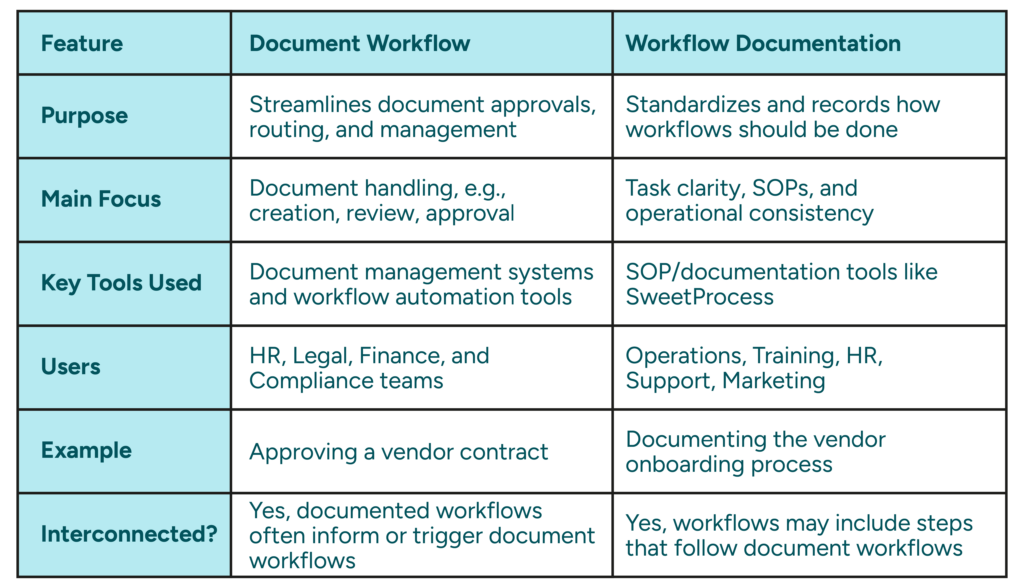
Despite the difference in focus, both document workflow and workflow documentation help organizations reduce errors and streamline operations. You can easily integrate them into your existing processes to keep your team compliant and accountable.
You need both, one to manage your documents and the other to guide your people.
Want a tool that helps you do both? Try SweetProcess and start documenting your workflows while managing the movement of critical documents across your organization, all in one place.
Workflow Documentation Examples & Templates To Inspire Your Team
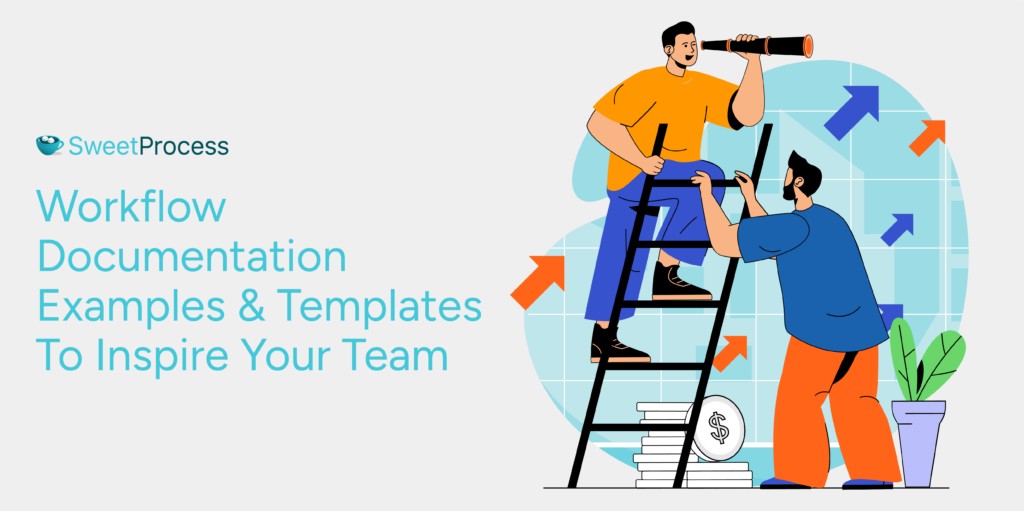
Need help getting started with workflow documentation? Here are some templates to help you visualize what a well-documented workflow looks like and how to build one that works for your team.
Employee Onboarding Workflow Template
This template helps HR teams streamline the onboarding journey, from sending the welcome email to conducting 30/60/90-day reviews. With this, you can send well-documented tips to your new hires to speed up their integration into the company. Here’s an example:
Industry: Human Resources / Corporate
Objective:
To onboard a new employee smoothly and ensure they are fully integrated within the first 90 days.
Who’s Involved:
- HR Manager
- IT Support
- Department Manager
- New Employee
Tools Needed:
- HR software
- SweetProcess
- Company intranet
Steps:
Pre-Boarding (Before Day 1)
- Send a welcome email with the start date, office location/Zoom link
- Share the employee handbook and onboarding schedule
- IT sets up email, accounts, and access
Day 1
- Office/virtual tour and introductions
- HR collects signed documents
- Department manager outlines team structure and role expectations
Week 1
- Complete mandatory training (policies, tools, compliance)
- Assign the first shadowing task or a small project
- Set up weekly 1:1 check-ins
Day 30/60/90
- Conduct progress reviews
- Collect feedback from both the employee and the manager
- Confirm full onboarding completion
Invoice Approval Workflow (Finance Template)
This template is perfect for finance and procurement teams. It can be used to map out steps for handling invoices, approval, and payments, ensuring that your organization doesn’t miss payments.
Objective:
To process and approve incoming invoices in a timely and accurate manner.
Who’s Involved:
- Vendor
- Department Head
- Finance Officer
- Accounts Payable Team
Invoice Submission
- The vendor sends the invoice to accounts@company.com
- Finance logs the invoice with the received date
Department Review
- Forward the invoice to the relevant department for validation
- Department head approves or flags issues
Finance Approval
- Cross-check vendor info, PO number, and payment terms
- Schedule payment or resolve issues if flagged
Payment & Archiving
- Process payment through accounting software
- Mark as paid and archive in the financial records
Patient Intake Workflow Template
If you run a clinic or healthcare facility, this template can standardize the intake process for new and returning patients. You can use it to verify insurance or outline steps for consultation, which helps reduce wait times and enhances the quality of patient care.
Objective: To collect complete patient information before consultation to ensure quality care.
Team Members:
- Front Desk
- Nurse
- Physician
- Patient
Tools Needed:
- EHR system
- Patient intake form
- SweetProcess
Workflow Steps:
Pre-Appointment
- The patient fills out the online intake form
- Verify insurance details and ID
Check-In
- Confirm arrival and update contact information
- Provide a health questionnaire if needed.
Pre-Screening
- The nurse takes vitals and records notes
- Review patient history
Consultation
- The doctor reviews records and meets the patient
- Add notes, prescriptions, and follow-up steps in the system
Content Publishing Workflow (Marketing Template)
Your marketing team can use this template to document the content lifecycle, from brief creation and writing to editing, design, and publishing. It keeps content quality high and ensures everyone knows their role.
Workflow Objective: To ensure all content is properly reviewed, optimized, and published on time.
Team Members
- Content Writer
- Editor
- Designer
- SEO Specialist
- Marketing Manager
Workflow Steps:
Content Drafting
- The writer creates a draft based on a brief
- The SEO specialist suggests keywords and structure
Editing & Review
- Editor reviews content for grammar, flow, and accuracy
- Feedback incorporated and final approval given
Design
- Designer adds visuals such as infographics and a cover image
- Format blog post in CMS with appropriate tags
Publishing and Promotion
- Schedule or publish a post
- Share on social media, newsletter, and Slack channels
- Track performance and comments
Document and Manage Your Company’s Workflows Using SweetProcess
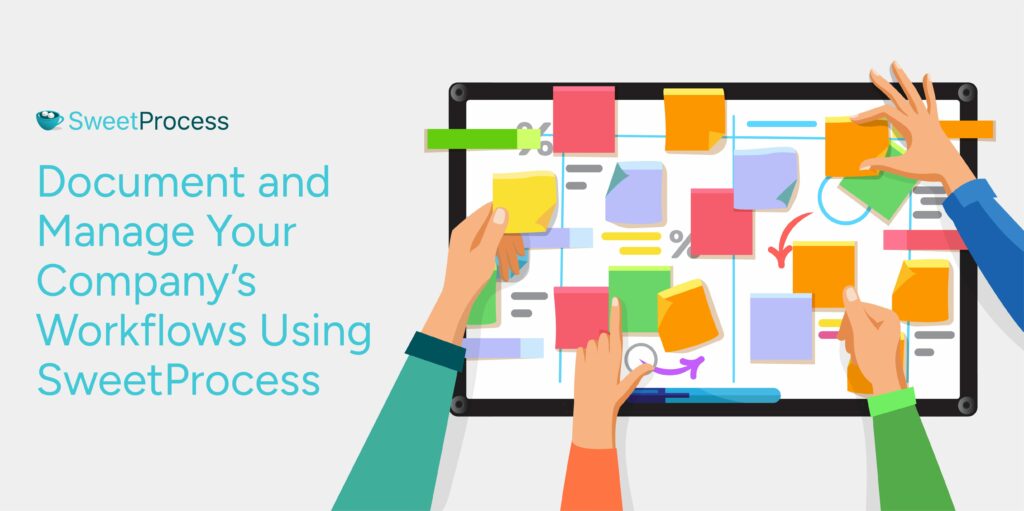
When your processes are clearly documented, your team knows exactly what to do, how to do it, and who is responsible. Documenting and managing your workflows makes this possible by speeding up onboarding, improving consistency, and allowing employees to work independently.
That’s why you need a tool like SweetProcess. This platform simplifies your workflow documentation process by allowing your team to co-create and manage all company information from one place. You don’t have to worry about tribal knowledge since everyone can access the centralized knowledge base with all the workflows.
Your organization can rely on SweetProcess for all your workflow management needs. Sign up for a 14-day free trial today. No credit card is required!
